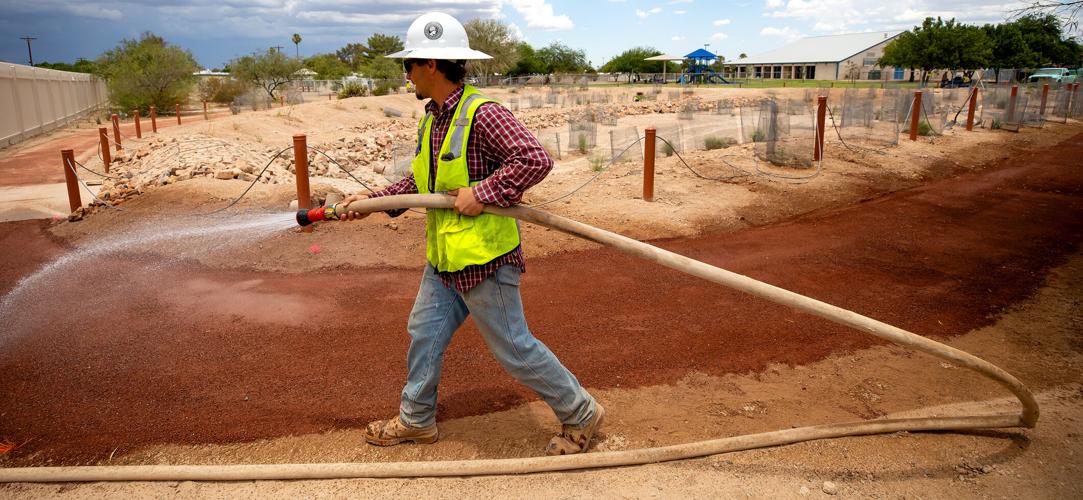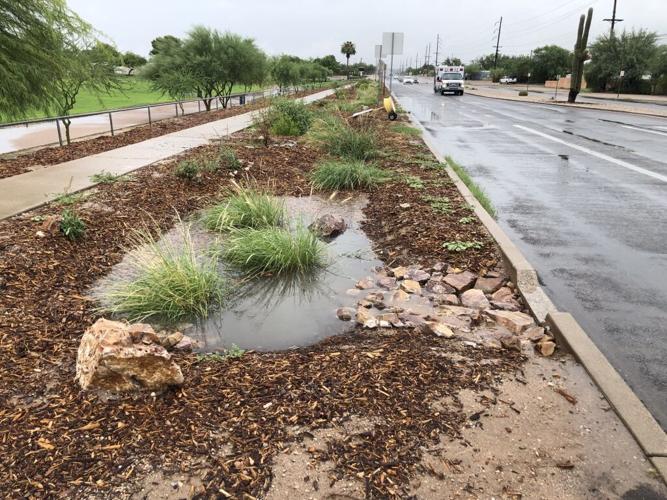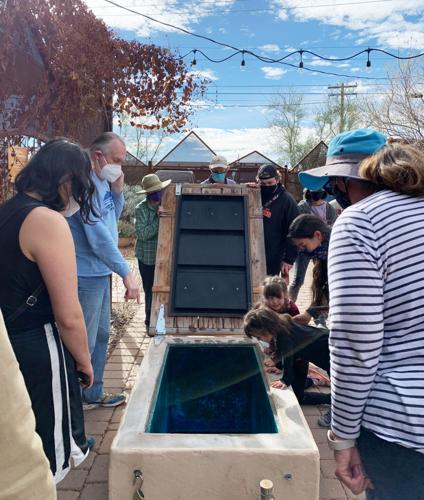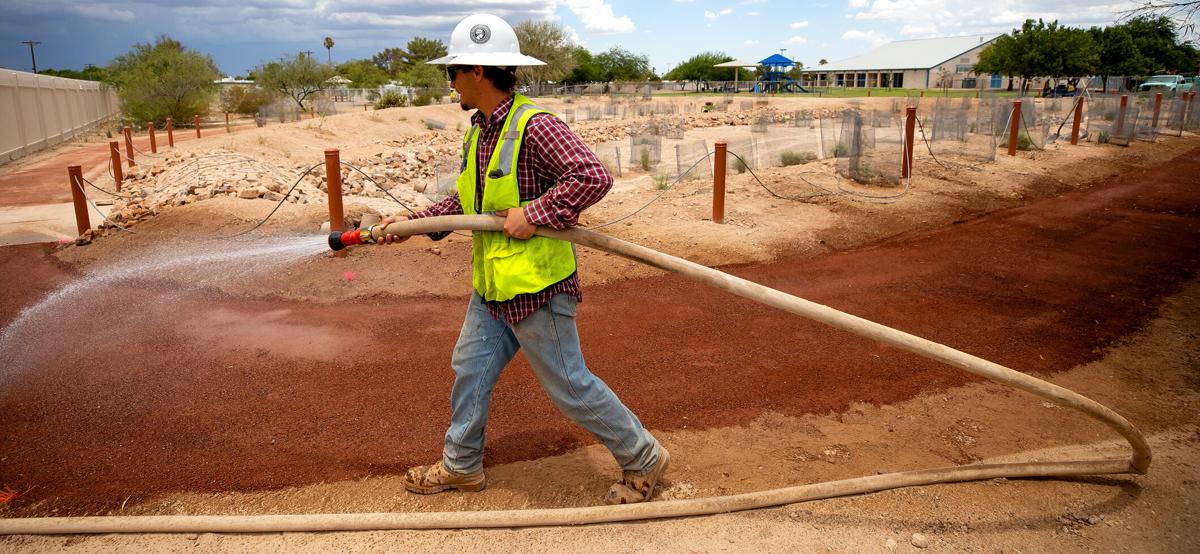As concerns mount about dwindling Colorado River water supplies, a series of new water conservation requirements may be imposed on residential and business development in Tucson starting next year.
At the direction of the Tucson City Council, the Tucson Water utility is studying five measures, ranging from a requirement for “green infrastructure” such as designs friendly for rainwater harvesting for new subdivisions, to requirements for commercial, townhouse, condominium and apartment developers to install meters specifically designed to measure outdoor water use.
Those ideas were first suggested by the utility this spring, and given the go-ahead for further study of costs and benefits in a unanimous council vote in early June. Tucson Water expects to have a report on its findings for the council by October, with a goal to have “some or all recommended actions” in effect by 2023, the utility told the Star.
One proposal under review would be one of the first if not the first such regulations of its kind nationally: a “net zero” water use mandate for new development.
Suggested by Councilman Kevin Dahl, it would require a new project to offset its expected water use by paying an existing user or group of users or taking some other steps to reduce use.

Councilman Kevin Dahl
Since the June 7 council vote, a water “bombshell” that could result in major cuts to the city’s drinking water supply has been dropped by the U.S Bureau of Reclamation.
On June 14, Reclamation Commissioner Camille Touton told a U.S. Senate committee that the seven Colorado River Basin states, including Arizona, must reduce their water use up to 28% next year to counteract a prolonged period of steadily declining water levels at Lake Mead and Lake Powell.
Without such action, both reservoirs could fall to “dead pool” levels at which virtually no water could be removed, or drop to levels at which the adjoining Hoover and Glen Canyon dams could no longer generate electricity — by 2026 at the latest, the bureau has said.
It’s not clear how these cuts will affect Tucson Water’s annual Central Arizona Project supply of 144,191 acre-feet of river water. The basin states and the bureau have until mid-August to reach agreement on how future cuts would be apportioned.
Then, water users and officials within Arizona and the other states would have to decide how to share the cuts inside each state. Officials of Arizona, California and Nevada — the three Lower River Basin states — are now holding private negotiations to come up with a plan to divvy up the cuts.
But Tucson Water officials say they don’t believe any additional city measures need to be taken beyond the proposals they were already studying before the June 7 council vote, because they had anticipated the bureau’s actions in advance.
Two water conservation advocates disagree, saying the city needs to protect itself further against uncertainties in the river’s supply.

Students from Flowing Wells Junior High School installed an 800-foot-long rain garden along La Cholla Boulevard last year. The school in partnership with Watershed Management Group plans to expand the garden into four more sections of La Cholla Boulevard by the end of 2022, envisioning a fully green boulevard with water harvesting.
Reducing water use
Specific proposals for new development under study by Tucson Water would:
Require new construction projects to install EPA “Water Sense”-certified plumbing fixtures including toilets, faucets and shower heads. “Water Sense” equipment typically uses 20% less than standard fixtures.
Create a “low impact development” ordinance to require new residential development to include “green stormwater infrastructure” to water outdoor landscaping with rainfall. Typically, “green infrastructure” includes passive water harvesting systems that design yards to route stormwater directly to trees and shrubs.
The “net zero” requirement.
Requiring separate irrigation meters to measure outdoor water use for new commercial and multifamily projects over a specified size. Developers would pay the utility to install such a meter. It would be connected to the city’s water system.
Requiring developers to monitor outdoor water use could greatly increase the effectiveness of the city’s commercial rainwater harvesting ordinance, utility officials said. The ordinance requires all new commercial and apartment developments to insure that half their outdoor water use comes from rainfall.
Requiring irrigation “submeters” for new townhome and condominium developments. Submeters, unlike irrigation meters that are installed and monitored by the city, are purchased and installed by a project developer or owner. They can monitor a project’s total water use or the use of individual townhomes or condos.
Submeters have been proven to significantly reduce water use in multifamily projects, the utility says, and provide residents greater control over their water consumption.
The city also plans measures to reduce existing customers’ water use, but they will be voluntary, unlike the mandatory proposals for new developments.
First, the utility will look at increasing city rebates for homeowners who buy low-flow toilets, using no more than 1.1 gallons per flush, and who plant landscapes that encourage passive rainwater harvesting.
Tucson Water is also launching what it calls a “comprehensive, conservation-centered” marketing and outreach campaign. It will include TV, radio, print, outdoor, and social media advertising, plus videos and visuals “to increase public engagement.” The utility will also work with various other city departments to implement recommendations made from water efficiency audits of 91 city facilities.
The utility will also provide residential customers information on their monthly water bills about how their water use compares to that of average customers. For residents with high uses, the utility will offer free audits, rebates and other conservation-related recommendations.
In a May 5 memo to the council, Tucson Water Director John Kmiec noted, “Through decades of planning, investment, and concerted conservation effort by our community, the city of Tucson remains one of the best prepared communities in the Southwest to manage changing conditions on the river.
“However, the speed at which drought is deepening necessitates a tangible and meaningful response. This is needed not only to reassure the public, but to provide more ways that citizens can participate in a new chapter for water stewardship in our community,” Kmiec said.
Making water-conservation real
At the June 7 council meeting, Mayor Regina Romero said, “Absolutely, we have to act as quickly as we possibly can.”
She added that the desire to avoid deeper cuts in CAP supplies was one reason Tucson joined the Gila River Indian Community in May in offering to leave a substantial portion of their CAP supplies in Lake Mead next year.
At the time, the city was offering to leave 30,000 to 35,000 acre-feet — a number that could be at least somewhat higher under the reclamation agency’s more recent, draconian plan.
“Don’t get me wrong, this community, the water department, previous councils and this council have done an incredible job in conserving water,” Romero said. “What we have to do next is continue the conservation effort, do outreach, working with residential customers and look at potential new programs we haven’t talked about.”
Dahl framed his “net zero” proposal as an equity issue.
“We hear complaints of why do we allow a lot of new development when we’re talking water conservation. If new developments were required to achieve a net zero water gain, by buying offsets, by funding low flow shower heads, that would take away that argument and would help our future,” he said.
Councilman Steve Kozachik said he supports staff’s push for additional public outreach and education, but added, “Let’s make the education real. The duck was cute, but we’re beyond cute,” referring to the cartoon character in the city’s “Beat the Peak” water-saving push.
He also said big water users should pay more in the future, adding, “We need to take a look at the tiered water rate structure. The point is to provide a disincentive (to use so much water).”
Romero also advocated more steps to help low-income families install rainwater harvesting cisterns at their homes.
“If we were to even just fund 100 low-income homes per year, that could potentially save us 260,000 gallons a year, if we assumed 2,650 gallons are captured per cistern,” the mayor said.

William Harris with Northwest Landscaping screens plants inside a new stormwater basin at Cherry Avenue Park.
Homebuilders: ‘We want to be a partner’
Whlie homebuilders often oppose new land use regulations out of concern they’ll boost home prices, Southern Arizona Home Builders Association President David Godlewski said the association isn’t closing the door on any proposal raised in Tucson Water’s May 5 memo.
“We’re obviously at a state level looking at some very significant challenges going forward with our water situation as it related to shortages on the river. I fully expect all Arizona cities will be looking at what they can do. It’s important for homebuilders to be at the table working with municipalities,” Godlewski said.
“We want to be a partner,” he said. “We are in this together.”
Asked specifically about the “net zero” idea, he added, “That’s one that we would need to really have a better idea of how something like that would work, at least in concept,” before taking a stand.
Attorney Rory Juneman, who chairs the city’s Citizens Water Advisory Committee, said the water situation is serious enough that, “We need to look at all options and evaluate all options, and I think that is what Tucson Water is starting off with, balancing their effectiveness versus their costs.
“Looking at any water conservation measures is a good thing but we also need to make sure they’re balanced with any costs,” said Juneman, who also is board chair of the Metropolitan Pima Alliance. The nonprofit group advocates for what it calls “balanced residential and commercial land use policies that stimulate economic development and reasonably preserves our natural environment.”
“What I know is that Tucson Water and their decades of responsible management of the CAP water allotment and our aquifer and their groundwater recharge has put us in a good position where we don’t have to rush, where we can carefully evaluate new conservation measures,” Juneman said.
Ed Hendel, an environmental advocate who also sits on the water advisory committee, said he likes the city proposals, but that they won’t solve the city’s water problems.
“The main thing we should be doing is stopping uncontrolled development, and in rare cases where we do approve new development we should require rainwater harvesting and water efficient toilets that would reduce the water footprint,” Hendel said.
Asked for specifics, Hendel said the city should focus more on “building upwards not outwards. When we spread new houses across the desert, we’re spreading our dwindling water supply. It’s just less efficient. You have to build new pipes and infrastructure to go out there and build new roads. And it uses more water that way.”
More steps to save water needed
Right after Reclamation Commissioner Touton’s announcement, Tucson Water’s Kmiec said the utility may now have to take severe cuts in CAP deliveries to meet the goal for a 2 million to 4 million acre-foot cut across the entire river basin.
He noted, however, that the city has more than five years worth of CAP supplies stored underground as a backup, and that it has rights to a large supply of treated sewage effluent that could be treated further for drinking use.
But the city may also reach the point where it has to start pumping groundwater, beyond the CAP water it has been storing underground, he said.

Watershed Management Group docent Dan Stormont gives a public tour of a 10,000-gallon cistern at WMG’s Living Lab & Learning Center, which sends water from the monsoon rains to the building’s faucets for drinking, hand washing and bathing.
When asked if the utility now wants additional water-use curbs beyond those already discussed, the utility told the Star:
“The items for review as decided by Mayor and Council on June 7 are the appropriate policies for review. Tucson retains its leadership position in water management actions, and Mayor and Council’s water policies remain at the forefront of wise water stewardship.”
Local water conservation advocates Val Little and Eliza Stokes say the city needs to take additional steps to protect drinking water supplies from future uncertainties in river flows.
Little, founder of the nonprofit Water Conservation Alliance of Southern Arizona, is also a member of the city’s Citizens Water Advisory Committee. Stokes is communications and campaign manager for the nonprofit Watershed Management Group, which both installs and advocates for rainwater harvesting systems for homes and businesses.
“This moment absolutely calls for the city to take additional action to conserve water, our most precious resource,” Stokes said. “As a city, we can take much better advantage of our annual monsoon rains — which add up to more water than our entire city consumes in a year — by providing more financial support and incentives for homes and businesses to proactively store and harvest rainwater.
“Technology is readily available, and increasingly affordable, that allows homes, apartments and businesses to drink safely filtered rainwater from their faucets for many months of the year, and transition back to city water only when needed,” Stokes said.
Little called the measures already proposed “the easy stuff, the low hanging fruit that produces the least amount of blowback. When you get to the point of retrofitting existing technology or putting new requirements on existing users, it gets a lot harder. But while these crises are right in front of us, it makes it easier. It’s kind of a strike when the irons are hot situation.”
Photos: Central Arizona Project canal construction in 1979

Construction of the Central Arizona Project Aqueduct in Western Arizona in June, 1979. The canal supplies the Phoenix and Tucson metro areas with Colorado River water.

6/9/1979 Central Arizona Project construction. Photo by Joan Rennick / CitizenConstruction of the Central Arizona Project Aqueduct in Western Arizona in June, 1979. The canal supplies the Phoenix and Tucson metro areas with Colorado River water.

6/9/1979 Central Arizona Project construction. Photo by Joan Rennick / CitizenConstruction of the Central Arizona Project Aqueduct in Western Arizona in June, 1979. The canal supplies the Phoenix and Tucson metro areas with Colorado River water.

Construction of the Central Arizona Project Aqueduct in Western Arizona in June, 1979. The canal supplies the Phoenix and Tucson metro areas with Colorado River water.

6/9/1979 Central Arizona Project construction. Construction of the Central Arizona Project Aqueduct in Western Arizona in June, 1979. The canal supplies the Phoenix and Tucson metro areas with Colorado River water.

6/9/1979 Central Arizona Project construction. Photo by Joan Rennick / CitizenConstruction of the Central Arizona Project Aqueduct in Western Arizona in June, 1979. The canal supplies the Phoenix and Tucson metro areas with Colorado River water.

Construction of the Central Arizona Project Aqueduct in Western Arizona in June, 1979. The canal supplies the Phoenix and Tucson metro areas with Colorado River water.

Construction of the Central Arizona Project Aqueduct in Western Arizona in June, 1979. The canal supplies the Phoenix and Tucson metro areas with Colorado River water.









